We first saw her at 10 a.m. on Oct. 27, 2017.
She was eating. That's what monarch caterpillars do best. They eat. A lot.
"Where have you been?" I asked. "Where have you been hiding? Your siblings have long gone. Your buddies passed through here in late August and September on their way to their overwintering sites in Santa Cruz and beyond."
How could I have missed her? This one was a fifth in-star and almost ready to pupate.
"Let's see. When your mama laid the egg, you hatched in about three to four days. You'll be a caterpillar for 10 to 14 days. Then you'll be in the pupa stage for 10 to 14 days. But that's all under normal conditions, summer conditions. This is fall, not normal conditions, little buddy."
The chubby black, yellow and white monarch caterpillar kept eating. "YOU could have been eaten, little buddy," I told her, glancing at the hungry California scrub jays vocalizing in the cherry laurels. True, milkweed contains a poisonous toxin that protects monarchs from predators, but birds do eat them. "Just not as much," says Louie Yang, associate professor of entomology at the University of California, Davis.
Then there are the other deadly encounters. Tachinid flies and braconid wasps parasitize the caterpillars and chrysalids. And some fall victim to that dreaded disease, Ophryocystis elektroscirrha, caused by an obligate, protozoan parasite.
Give her a chance, just a chance...
So, awed by her unexpected appearance, we prepared the indoor butterfly habitat for its last tenant of the season. Our monarch-rearing kit features a Patron tequila bottle; the narrow neck prevents the 'cats from drowning, and the broad, heavy base assures stability (this is one bottle that doesn't get tipsy!). Just add water, milkweed stems and the caterpillar, and center the bottle in the zippered habitat. Then you wait for the caterpillar to create a silk button and form a J. And then a chrysalis. And then an adult ready to generate more generations.
This November tenant, however, chose the most fragile, overhanging milkweed stem in the bottle to pupate. No mesh ceiling for her!
When the jade-green chrysalis formed on Nov. 4, it looked like a jeweled ornament dangling from a Christmas tree. Or a mid-life chrysalis.
Now, "hurry up and wait." In ideal conditions, a monarch ecloses in 10 to 14 days. In ideal conditions.
Nothing happened for 10 days. Then 12. Then 14. Then 18.
On Day 19, Nov. 22 (the day before Thanksgiving), the chrysalis darkened, revealing the orange, black and white wings in all its transparency. The chrysalis bulged, throbbed and swayed. Out slipped the butterfly, wings flat, wings pumping. She clung to the pupal case as her wings expanded. A big, strong and healthy girl.
On Thanksgiving Day, four adults, two dogs and one butterfly celebrated in Casa de la Garvey. At least we think the butterfly celebrated. She dropped to the floor of her habitat and sipped orange juice and a honey/water mixture. Then, sustained, she fluttered up to her perch, and began searching for an opening, an escape.
She. Wanted. Out.
Hmm...No way would she be able to fly three hours to the overwintering site in Santa Cruz in the cold and rain. And then there are those hungry California scrub jays hanging out in the cherry laurels...Just waiting...
It just so happened that a friend and pollinator advocate, Rita LeRoy, the self-described "farm keeper" at the Vallejo School District's Loma Vista Farm, Vallejo, was heading to Santa Cruz on Friday, the day after Thanksgiving, to show her out-of-town relatives the overwintering migratory butterfly sanctuary at the Natural Bridges State Beach Park. That's about a 100-mile trip from Vallejo.
Could Ms. Monarch hitch a ride?
She could. And she did.
Rita, who delights in showing area schoolchildren the monarchs that frequent Loma Vista Farm--she's also a Monarch Mom who rears and releases monarchs and is active in the Bay Area Pollinator Posse--unzipped the mesh habitat at the butterfly sanctuary.
Freedom.
Her sister-in-law captured an image of Miss Monarch in freedom's hands.
Wow! Just wow! From a caterpillar to a chrysalis to an adult. And there she was! In Rita's hands. In Santa Cruz. In the migratory butterfly sanctuary. With her buddies. Or soon-to-be buddies.
"She flew so fast that we didn't get a picture of her flying away," Rita lamented. "She was anxious to join her new friends."
"It was a beautiful day," Rita said, adding "Thank you for allowing me the pleasure of setting her free. I was so sad that my last ones (monarchs) didn't survive. It was really nice to have this happy experience."
Once upon a monarch...thanks to Rita, the ending could not have been better...
Attached Images:
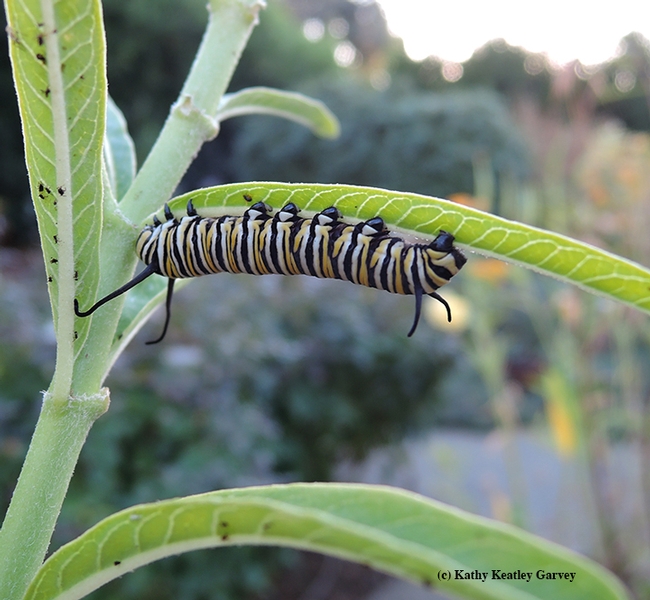
A monarch caterpillar dines on tropical milkweed on Oct. 27, 2017 in Vacaville, Calif. (Photo by Kathy Keatley Garvey)
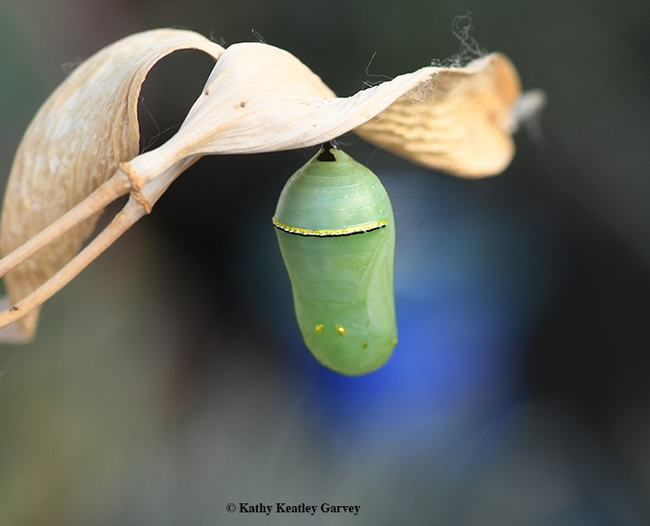
The monarch caterpillar, found Oct. 27 on milkweed in Vacaville, Calif., formed this chrysalis on Nov. 4. (Photo by Kathy Keatley Garvey)
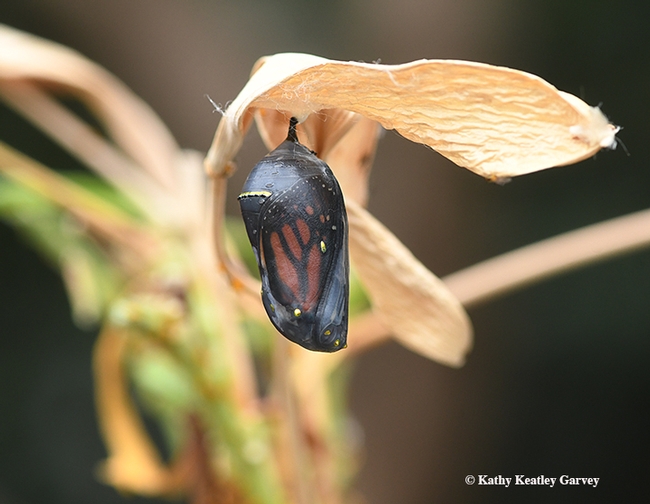
On Nov. 22, the chrysalis darkened, revealing the iconic orange, black and white wings of the monarch in all its transparency. (Photo by Kathy Keatley Garvey)
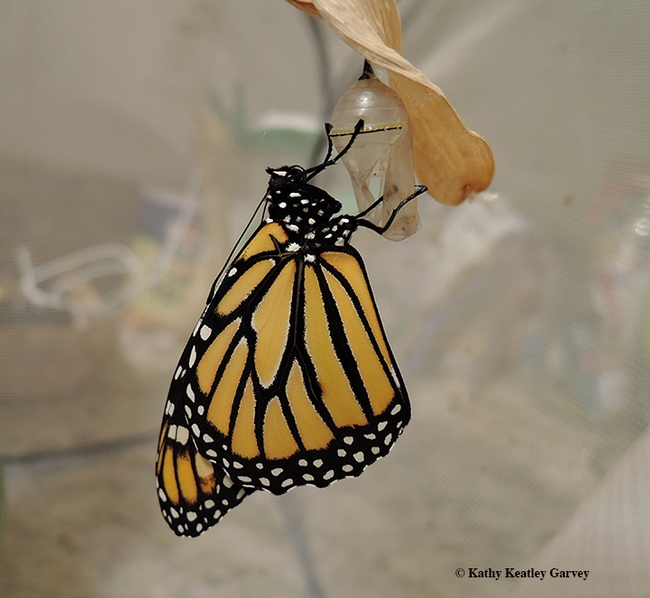
On Nov. 22, the monarch eclosed. It's a girl! Here she clings to her pupal case. (Photo by Kathy Keatley Garvey)
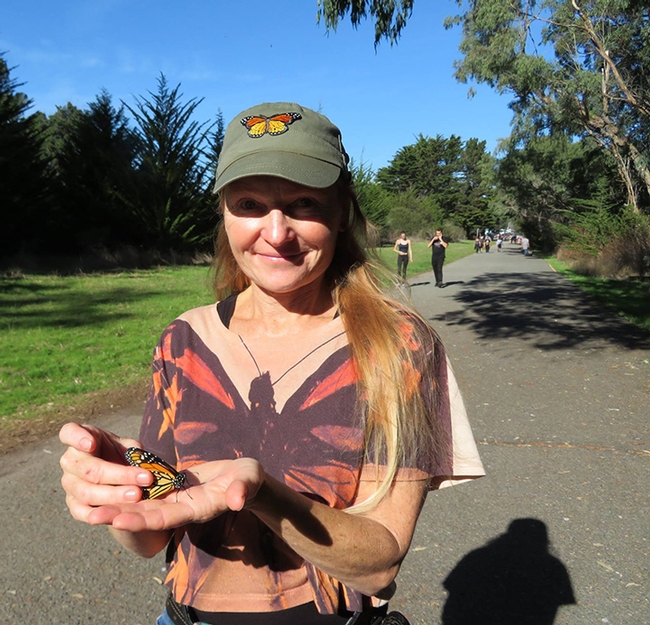
Monarch Mom Rita LeRoy, farm keeper at Loma Vista Farm, Vallejo, is ready to release the Vacaville-born and reared monarch at the butterfly sanctuary at Natural Bridges State Park, Santa Cruz, on Nov. 24.